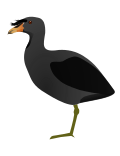white filoplumes on the head in the breeding season vary with both the age of the bird, and the subspecies; older birds have more white filoplumes than...
27 KB (2,576 words) - 10:01, 27 October 2024
feathers (e.g., barbules, rachides and vanes); types of feathers (e.g., filoplume, pennaceous and plumulaceous feathers); and their growth and loss (e.g...
289 KB (31,050 words) - 07:53, 2 November 2024
centimetres of their eyes. Caught prey can be felt by owls with the use of filoplumes—hairlike feathers on the beak and feet that act as "feelers". Their far...
70 KB (7,573 words) - 20:56, 5 August 2024
than other birds; lastly the filoplumes are small (less than 1 cm long) naked shafts that end in a splay of fibers— filoplumes were believed to give flying...
82 KB (8,050 words) - 01:55, 28 October 2024
developed, there are six different types of feathers: contour, flight, down, filoplumes, semiplumes, and bristle feathers. Feathers were not originally meant...
11 KB (1,677 words) - 02:41, 30 June 2024
Mechanoreceptors at the base of the filoplumes only fire when contour feathers are displaced or the filoplume moves. Preening enables birds to remove...
48 KB (5,269 words) - 01:49, 6 September 2024
around 12 million years ago. Given that the head ornamentation by yellow filoplumes seems plesiomorphic for the Eudyptes-Megadyptes lineage, Madrynornis probably...
14 KB (1,079 words) - 22:58, 10 March 2024
Here, asymmetrical flight feathers, bipinnate plumulaceous feathers, filoplumes, powder down, and bristles evolved. Some evidence suggests that the original...
51 KB (4,957 words) - 01:12, 7 October 2024
yellow-throated bulbul, which is found in rockier habitats. Three or four hair-like filoplumes are present on the nape. Sexes are similar in plumage. It is usually detected...
6 KB (672 words) - 23:10, 20 December 2023
white tufts appear on the sides of the head, there are scattered white filoplumes on the side of the head and the neck, and the throat patch develops a...
12 KB (1,263 words) - 00:19, 16 September 2024
adult bird has a glistening all black plumage with some white spots and filoplumes on the face. There is also a short crest on the back of the head. The...
13 KB (1,524 words) - 08:57, 20 April 2024
brown and the feet are pale bluish. The nostrils are covered by tufts of filoplumes. The feet are heterodactyl, a feature unique to the trogons, with the...
13 KB (1,630 words) - 21:43, 28 September 2024
top of the head and one at the nape), white thighs, and scattered white filoplumes on the head and neck. The long thin bill and the large feet with all-webbed...
25 KB (2,894 words) - 05:03, 10 May 2024
described the species in 1817. Nestlings of this species are orange with long filoplumes that end in white tips and have a resemblance to hairy caterpillars of...
4 KB (315 words) - 21:51, 2 May 2024
tiny feather known as a filoplume, which acts as a mechanical sensor. When the crest feathers begin vibrating, the filoplume triggers a nerve cell, translating...
13 KB (1,507 words) - 03:28, 30 October 2023
Avifilopluma ("bird filoplumes") is a clade containing all animals with feathers. Unlike most clades, which are defined based on relative relationships...
7 KB (768 words) - 01:42, 6 September 2024
with a slightly paler underside. They have scattered areas of white filoplumes behind the eyes and down the neck. The wing coverts have a speckled, silvery...
14 KB (1,579 words) - 17:06, 15 September 2024
and may possibly be erectile. The three wattles terminate in tufts of filoplumes. At the base of the beak and below the wattle is a fleshy caruncle which...
5 KB (525 words) - 01:59, 11 August 2024
purplish-blue sheen. The head has a prominent crest and there are white filoplumes on the neck. Adults have a red gular sac and orange-red caruncles on the...
15 KB (1,717 words) - 02:22, 22 October 2024
rather paler grey. The head sometimes has a brownish tinge, and bears filoplumes. The beak is long and slender, and the tail is long and is frequently...
10 KB (1,064 words) - 15:30, 28 September 2024
as suggested by the name, an erectile crest. Both genera have unique filoplumes (hairlike feathers) on the flanks that are not visible in the field and...
7 KB (869 words) - 03:15, 11 August 2024


















